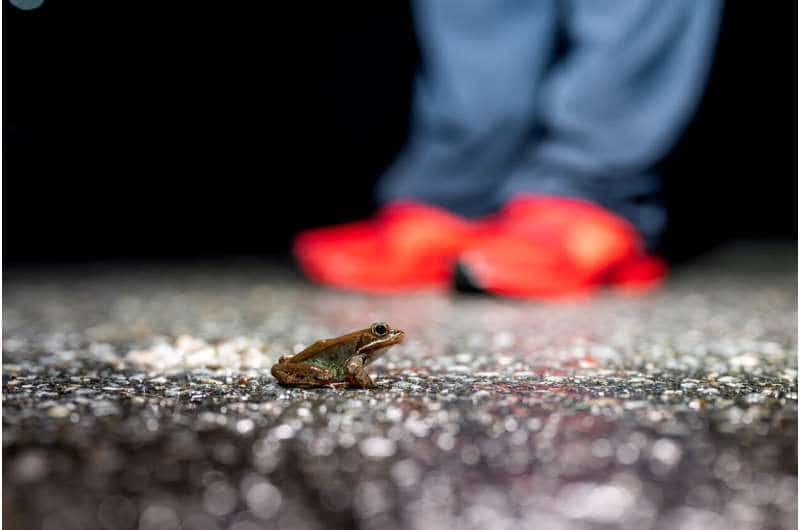This post was originally published on Eco Watch
Amphibians like frogs and salamanders face mounting threats around the world, including habitat loss, climate change, deadly fungus and road mortality.
Roads pose an immediate danger by cutting amphibians off from crucial migration corridors and putting them in the path of vehicles, which kill millions of animals annually.
Now, a first-of-its kind study led by researchers from University of Vermont (UVM) shows that wildlife underpasses can reduce amphibian deaths by more than 80 percent while helping to preserve ecosystems.
Over a decade of research by scientists and citizens from the Vermont Agency of Natural Resources, the local community and University of Vermont assessed the effectiveness of a pair of wildlife underpass tunnels installed under a road located in Monkton, Vermont, a press release from UVM said.
A frog attempts to cross a road in Monkton, Vermont. Joshua Brown / University of Vermont
The two underpasses led to an incredible 80.2 percent fewer amphibian deaths.
“It was surprising. I knew that underpasses would work, but I didn’t think they would be that effective,” said lead author of the study Matthew Marcelino, an ecologist at UVM. “And when we took climbing amphibians out of the picture — which in our context are primarily spring peeper frogs — we noticed a 94% decrease in mortality in the treatment areas.”
The research team monitored the road mortality of amphibians in the area from 2011 to 2015 before constructing the underpasses and from 2016 to 2022 after construction.
They compared three zones: the first a treatment with underpasses and wing walls; the second a buffer area at and beyond the edge of the wing walls and away from the tunnels; and the third a control area far away from the infrastructure changes.
Standardized surveys were conducted during brief spring migration windows across a dozen species of toads, frogs and salamanders. Initially the team found a total of 5,273 amphibians, including 2,545 peeper frogs — almost 70 percent of which were deceased — and 1,702 spotted salamanders, almost half of which were also dead.
The death rates were significantly lower in treatment and buffer areas, where the animals had been using the tunnels rather than being displaced.

The study is the first to provide long-term evidence of the effectiveness of amphibian-specific wildlife underpass tunnels in the northeastern United States. It highlighted that design details such as wall height and angles, materials and tunnel layout make a difference.
“Amphibians — frogs, toads, and salamanders — play vital roles in ecosystems and are highly sensitive to environmental disruption,” the press release said.
Many amphibians in Vermont and a large portion of the Northeast spend most of their lives in upland forest streams or soils, including long winters underground. They emerge in early spring on temperate, rainy nights to begin their migrations from woods to wetlands, flooded meadows and ponds to breed.
“It’s usually sometime between late March and late April,” explained ecologist Brittany Mosher, senior author of the study and a professor at UVM’s Rubenstein School of Environmental and Natural Resources. “Many species will breed in the same ponds. So it’s not just a single species migrating — it’s many, many species. And oftentimes, we see hundreds or thousands making this movement all at the same time.”
Roads frequently stand in the way of amphibians’ journeys from upland forests to aquatic habitats.
“Planners — state and federal transportation planners — often build roads between these steeper forested upland habitats and nice flat aquatic habitats,” Mosher said. “So the roads are placed exactly in the wrong spot if you were an amphibian planner.”
Because they are small and move slowly, amphibians are particularly vulnerable to vehicle collisions.
“Unlike larger mammals that might dart across a road in seconds, frogs and salamanders can take several minutes to cross — and with hundreds migrating at once, mortality rates can be staggering,” the press release said.
The cost of the 0.81-mile stretch of road that the underpasses cover was $342,397 — much lower than that of large overpasses and underpasses designed for mammals, which can run anywhere from $500,000 to almost $100 million each.
The amphibian underpass design features two concrete tunnels that are four feet wide with wing walls that help guide them toward the tunnels and underneath the road.
The Lewis Creek Association used wildlife cameras to count 2,208 amphibians using one underpass in 2016. Other animals also took advantage of the tunnels, including bobcats, porcupines, bears, snakes, birds and racoons.
The researchers emphasize that their findings should be used as a model for policymakers and road planners across the country.
“This study provides strong evidence that wildlife underpasses work,” Marcelino said. “We hope this will encourage transportation departments to include them in future plans, when building or repairing roads.”
Mosher added that the underpasses are not only helpful for amphibians, but demonstrate that communities can work together to protect local wildlife.
“This story began with local community members who were engaged and concerned,” Mosher said. “And it provides a view for how other communities can protect their amphibian populations too.”
The study highlights the crucial role of research, community engagement and investment in targeted infrastructure to support biodiversity.
“Conservation takes commitment,” Marcelino said. “But when we invest in good tools and take the time to do it right, the payoff for ecosystems and wildlife can be enormous. These are beautiful creatures — so beautiful, so ancient.”
The findings of the study, “Assessing the Efficacy of Wildlife Underpasses in Mitigating Amphibian Road Mortality: A Case Study from the Northeastern United States,” were published in the Journal for Nature Conservation.
The post Wildlife Underpasses Can Reduce Amphibian Road Deaths by More Than 80%: Study appeared first on EcoWatch.





0 Comments